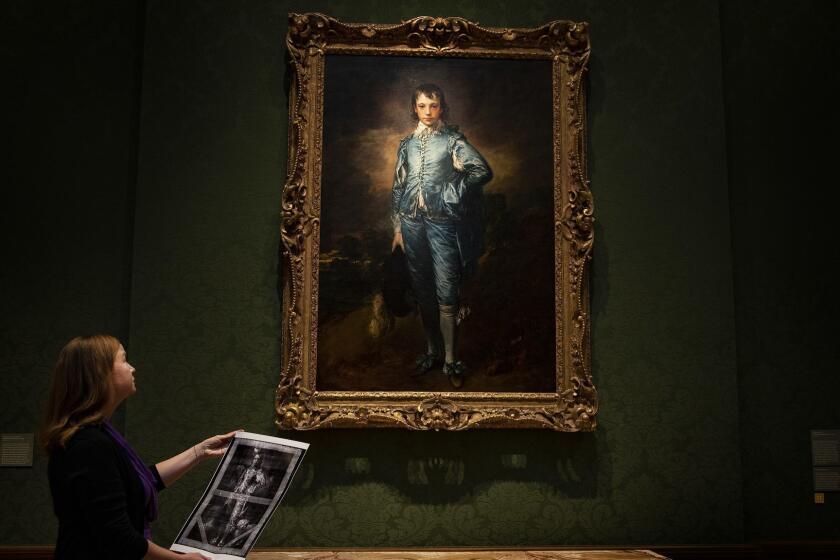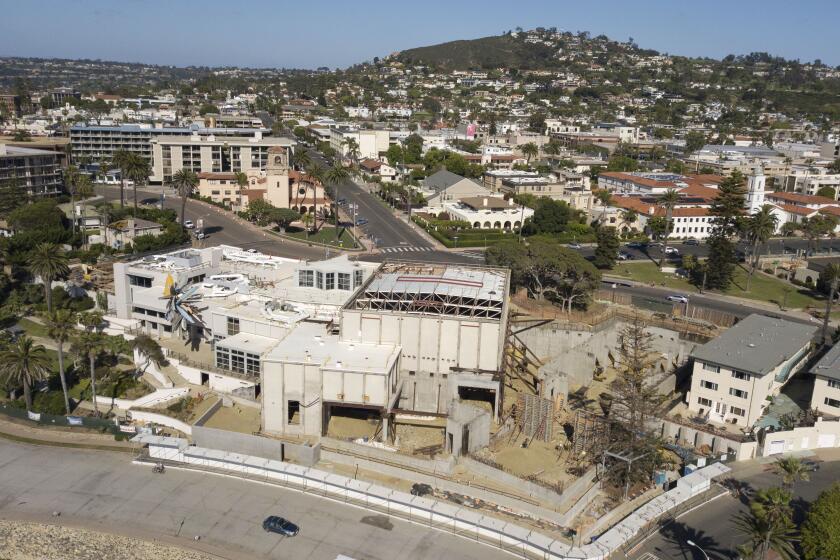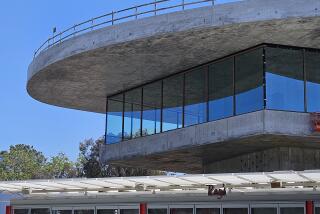Commentary: ‘The Blue Boy’ is returning to London. Why experts fear the trip presents a grave risk to a masterpiece
Huntington Art Museum officials are overruling their own conservation experts’ advice by lending the fragile painting to Britain’s National Gallery.
Thomas Gainsborough’s “The Blue Boy,” arguably the most famous European Old Master painting in America, will travel to London for a January exhibition at Britain’s National Gallery — the first time the beloved icon has left the walls of the Huntington Library, Art Museum and Botanical Gardens in San Marino since it was acquired a century ago.
“We were shocked,” Mark Leonard said when The Times asked about the decision made last week by the museum’s board of trustees. Leonard, the retired conservator of paintings at the J. Paul Getty Museum, is a leading voice in the conservation field. The “we” is a panel of nine prominent American and European art conservators convened at the Huntington in December 2018 to evaluate the painting’s condition.
Sending the picture abroad was unanimously opposed by the expert team, who believed travel puts the prized work at grave risk. They warned of potential structural damage to the 250-year-old canvas from the arduous trip. Museum administration overruled their advice.
The Huntington’s signature work of art is a brilliant picture of a life-size, ruddy-cheeked youth costumed in the flashy blue satin tunic, breeches and cloak of an aristocrat of an earlier time. It was last seen in Europe at London’s National Gallery before departing by steamship for the United States. The surprise announcement of its planned journey back to the United Kingdom was wrapped in excited tributes.
“A grand return.” “Unprecedented.” “A once-in-a-century opportunity.”
Ninety thousand people jammed the National Gallery in January 1922 to say goodbye to what many regarded as a national treasure being lost. Eager throngs likewise can be expected during next year’s four-month visit, guaranteed to be a media sensation.
The team of conservators was evaluating a course of essential treatment for the delicate canvas, while the possibility of the loan was already being discussed. They cautioned that the picture should never travel.
Among the group was Michael Gallagher, conservation head at New York’s Metropolitan Museum of Art; Rica Jones, a Gainsborough specialist who is retired conservator at Tate Britain, the national collection of British art housed in London on the banks of the Thames; Mark Aronson from the Yale Center for British Art in New Haven; and Mikkel Scharff, head of the Institute of Conservation at the Royal Danish Academy in Copenhagen.
A concise two-page document on Huntington letterhead recommending a plan of treatment for the masterpiece, reviewed by The Times, is unambiguous. It concludes that “the panel strongly recommends against lending ‘The Blue Boy.’”
In two paragraphs and seven bullet points, the admonition is repeated three times. The panel’s own suggested conservation treatment was even cited as a reason for denying a loan.
Why the panel’s advice was rejected is unclear.
Huntington President Karen R. Lawrence did not respond to a request for comment. In a news release announcing the London exhibition, Lawrence said, “Given ‘The Blue Boy’s’ iconic status at the Huntington, this is an unprecedented loan, one which we considered very carefully.”
The art museum’s director, Christina Nielsen, said in an email that advisability of a loan was not part of the panel’s brief, “as we did not want treatment decisions inflected by travel considerations.” Nielsen said that after completion of the conservation work, a second panel of unnamed curators and conservators met in September 2019 and determined that a single loan to London could be undertaken.
Conservation standards usually favor the least invasive procedure to maintain an object’s artistic and historic integrity. “The Blue Boy” is distinctive in retaining much of its original structural wholeness.
Joseph Duveen, the aggressive New York art dealer who sold the masterpiece to Henry E. Huntington and his prominent art collector wife Arabella in 1921, regularly added new linings to the backs of Old Master canvases to spruce them up for sale to Gilded Age American plutocrats. The dealer’s crude relining process often resulted in flattened surface paint.
For reasons unknown, “The Blue Boy” escaped that common fate. It retains both a two-century-old lining — “delicate but healthy,” in Leonard’s description — and the lively surface brushwork for which Gainsborough is acclaimed.
Two conservation plans for stabilization of “The Blue Boy” were possible — one elaborate, the other minimal. The elaborate plan would interfere with the painting’s rare structural integrity. The minimal plan was therefore chosen, “predicated on the grounds that the picture not travel.”
The group also dismissed any thought of selecting a different course of action so that loans could be safely accomplished. “According to professional guidelines of practice and ethical conduct,” the conservators wrote, treatments are “not undertaken solely to prepare an object for potential travel.”
The Huntington completed the chosen conservation work over the course of 2019 and 2020. The lengthy procedure included removal of layers of yellowed varnish, thorough cleaning, adhesion of lifting and flaking paint, in-painting where losses were found, and stabilization of the canvas support and wooden stretcher bars.
Despite the expert panel’s warning, the museum then secured the loan arrangement. No loan fee is being charged, but an as-yet unannounced reciprocal loan has been guaranteed to the Huntington from the National Gallery.
Nielsen and Lawrence, former president of Sarah Lawrence College, had both been hired in San Marino just a few months before the international team of conservators met. Preparations for the institution’s own centennial celebrations in 2019 were then well underway. Looking back over the Huntington’s past, the iconic story of “The Blue Boy” loomed large.
Leonard, who had overseen conservation issues at the Huntington during his lengthy Getty tenure, before the San Marino museum brought its own full-time conservator onto the staff, was hired as a consultant to the project. He knew “The Blue Boy” well, having performed a minor treatment on the canvas just before his 2010 retirement.
Ironically, two participants in the team’s deliberations are affiliated with the two museums now involved in the loan agreement that the panel unanimously advised against.
There’s a mystery unfolding at the Huntington Library, Art Collections, and Botanical Gardens.
Paul Ackroyd is the highly regarded paintings conservator at London’s National Gallery. Huntington conservator Christina O’Connell proposed the chosen treatment.
It was executed during a fascinating exhibition, “Project Blue Boy,” which allowed the public to watch her at work on cleaning and restoration of the canvas in a studio set up inside a museum gallery. The painting has since been returned to its central place in the museum’s Thornton Portrait Gallery.
O’Connell and Ackroyd did not respond to requests for comment.
The journey to London from Los Angeles will be arduous for a delicate work of art. Dangers lurk.
The painting will be removed from its climate-controlled gallery, crated, trucked over surface streets to the airport, loaded into an airplane hold, flown across the country and an ocean (perhaps with a stop on the way), landed in London, trucked to the National Gallery, uncrated and installed in another climate-controlled gallery. In May, at the end of the exhibition, the procedure and itinerary will be reversed.
The conservation committee’s concern is that the structural instability of aging paints, canvas, wood and lining will be accelerated in ways that don’t happen to a fragile but largely intact Old Master painting hanging undisturbed on a museum wall. Transit vibrations and climate shifts are among primary worries, although they are unlikely to cause damage visible to the naked eye.
“There won’t be crumbs at the bottom of the crate when it gets back,” Leonard said. The harm will be more insidious.
Past loan requests for the picture, which is synonymous with the Huntington’s identity, have been rejected. Now, when a museum in Paris, Dubai or Shanghai comes calling, it will be harder to say no.
Breaking the precedent of refusing all loan requests creates a no-win situation for the institution. Saying no generates international ill will toward the Huntington from those who have been rebuffed, while saying yes sets the stage for further harm to the painting.
Before coming to America, “The Blue Boy” had been in the collection of the Duke of Westminster, said to be Britain’s richest peer who would later support Nazi appeasement. During World War I, the painting was sent for safekeeping to the National Gallery, where it remained until it was sold.
Duveen bought it from the Duke, who needed cash to pay taxes, in October 1921. That November, Henry and Arabella Huntington acquired it from Duveen for a princely sum — the equivalent of more than $11 million today. With great fanfare, the picture came cross-country by train to Los Angeles the following year.
The painting has hung in their sumptuous estate in the tony suburb of San Marino ever since.
Call it the ‘pandemic dividend’: A rising stock market helped endowments rise as much as 40%, yet museums are still selling pieces of their collections.
More to Read
The biggest entertainment stories
Get our big stories about Hollywood, film, television, music, arts, culture and more right in your inbox as soon as they publish.
You may occasionally receive promotional content from the Los Angeles Times.













